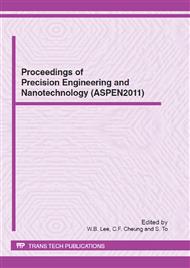p.160
p.166
p.170
p.176
p.181
p.186
p.192
p.198
p.203
Research on the Support and Gravitational Deformation of Large Aperture Primary Mirror of Space Telescopes
Abstract:
The surface figure of the primary mirror in a large aperture telescope is one of the key factors influencing imaging quality. Space telescopes are used in weightless environments, which is different from the ground environment for optical machining and testing. Therefore the effect of the deformation induced by gravity on the imaging quality is not negligible and the mirror support is to be carefully designed to unload the gravity during the course of machining and testing. In this paper, finite element analysis software is adopted to simulate and compare the deformation induced by gravity of a metre-scale aspheric lightweight primary mirror with different support methods and different working conditions. The results are then imported into MetroPro software supplied by ZYGO Corporation, to remove the tilts and rigid body motion of the mirror and calculate the primary aberrations from the deformation. Finally, sensitivity analysis of support deformation is implemented and the principles of mirror support design are summarized. The research is instructive for design, machining and testing of large aperture mirrors.
Info:
Periodical:
Pages:
181-185
Citation:
Online since:
June 2012
Authors:
Price:
Сopyright:
© 2012 Trans Tech Publications Ltd. All Rights Reserved
Share:
Citation:


